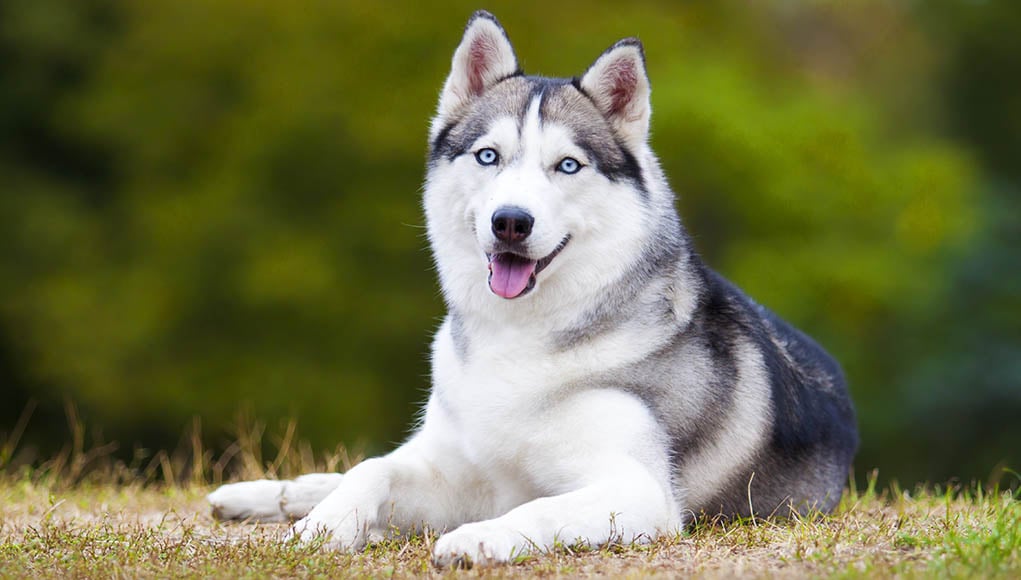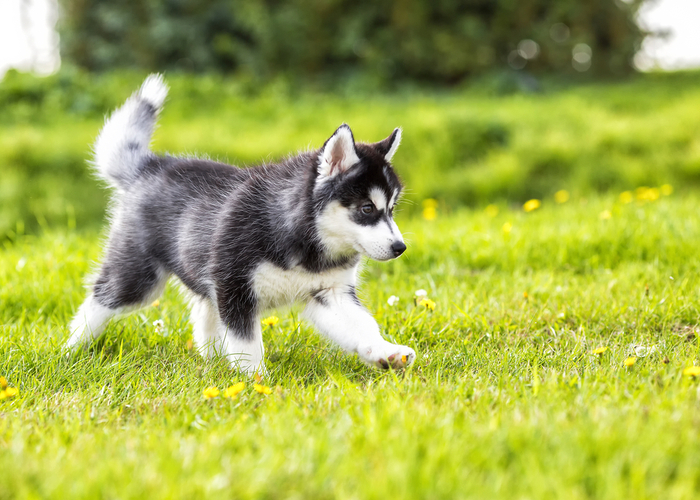Table of Contents
- Significant Characteristics of Siberian Husky
- Personality and Temperament of a Siberian Husky
- Feeding Siberian Huskies
- Grooming for Siberian Husky
- Lifespan of a Siberian Husky
- Living With Siberian Huskies
- Siberian Huskies with Children and Other Pets
- History of the Siberian Husky
- How To Find Your Siberian Husky
- Breeding Siberian Huskies
- In Conclusion, is a Siberian Husky the Right Dog for You?
The always-on-the-go Siberian Huskies are energetic, playful, and amiable dogs. They are born independent and intelligent.
Although Huskies are sometimes considered intense dogs and have high energy, they can also be affectionate and gentle when being adequately taken care of.
Siberian Huskies can be a great partner and friend to have. They love children, can be welcoming to guests, and quickly get along with other dog breeds.
If you have an active household with lots of time to spare for your dog and can give proper care and attention – a Siberian Husky will be a joy to have!
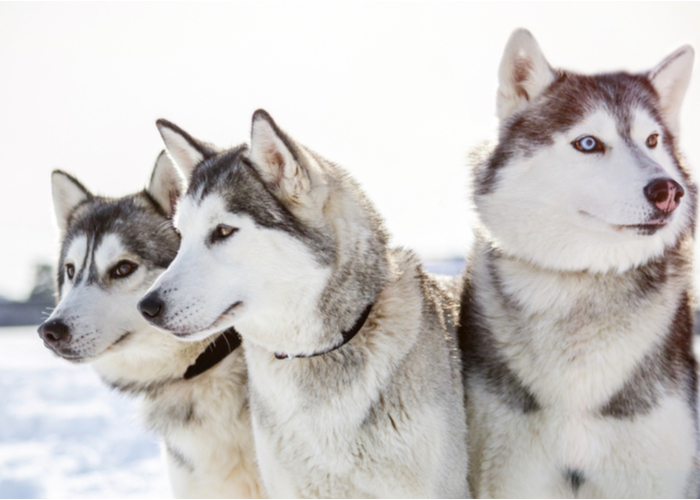
Significant Characteristics of Siberian Husky
As a dog breed developed in the snowy country, Siberian Huskies shed all year round, more so in spring and fall.
Siberian Huskies are not barkers, but they often howl, especially to sirens. They are one prominent escape artist and are known to climb and dig under fences.
They love to run and roam around the neighborhood if given a chance!
Huskies need to have identification tags on their collars at all times to ensure safe return after every escape.
They may be very aggressive to other stranger dogs, but they are friendly to the pets at home. Huskies are very social and need lots of human and canine companionship.
First developed as sled dogs, Siberian Huskies are remarkable dogs, and their ability to learn is stunning.
However, they are not very eager to please their owners. They are tough to train, so first-time dog owners should consider another breed.
Huskies fit well with experienced dog owners who set rules and can provide consistent leadership.
Like all other breeds, Siberian Huskies need obedience training because they have difficulty distinguishing between home and class – they tend to behave nicely in style. Still, they are a snob with orders at home.
RELATED ARTICLE: Dog Trainer Called as The Dog Whisperer
Although they may possess lots of complex qualities, Siberian Huskies are still a fascinating breed. When properly trained and cared for, Huskies can be excellent companions!
Size
An average male Siberian Husky stands at 21 to 23.5 inches, while a female Husky is only 20 to 22 inches tall. The male can weigh from 45 to 60 pounds while females are just 35 to 50 pounds.
Physical Characteristics
Siberian Huskies are strong, compact, and working sled dogs. Their appearance alone is very striking to everyone.
This medium-sized dog has a proportioned body with a well-defined muzzle equal in length to the skull. The color of its nose depends on the color of its coat.
Siberian Husky's teeth meet in a scissors bite.
Its tail is in a sickle curve that carries to the back.
Its feet have hair in between its toes to help keep them warm and proper gripping on ice. Dewclaws are sometimes removed.
Siberian Huskies have a piercing gaze and an almond-shaped eye with a color of amber, blue, and brown.
Some Huskies have bi-eyes, which means one-eyed is brown, and the other is blue. They can also be part-eyed and can be defined as half-brown and half-blue eyes.
Their faces are masked with white color and are distinguished by an elongated snout that helps give out warm air in cold climates, and they hold an alert and focused expression.
Siberian Huskies have a two-layered insulated coat that protects during snowy days and nights. It is straight and thick on the outside, short and soft on the inside.
A Husky's coat has various red, gray, black, white, patterned in red-and-white, black-and-white, and gray-and-white.
Vibrant colors surround their muscular shoulders and would rise to the tips of their high triangular ears. Colors then form a forehead cap to create an illusion of raised eyebrows.
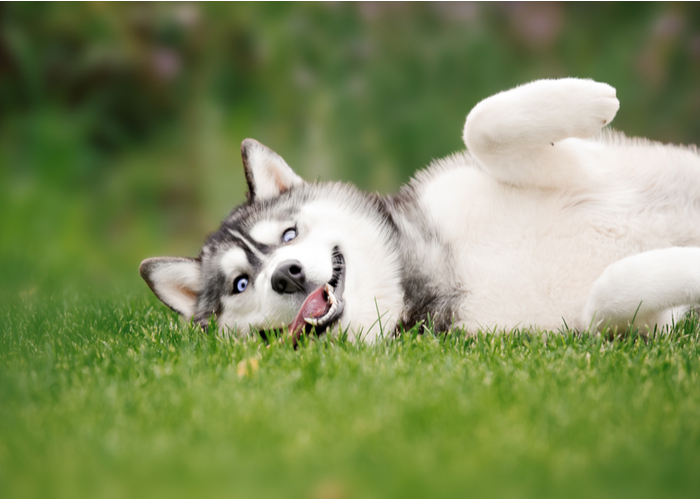
Personality and Temperament of a Siberian Husky
Siberian Huskies are naturally born pack dogs, and they need an owner who is a pack leader. This will make training easier for them because they can easily respect you.
This lively breed can be destructive both indoors and outdoors, especially when bored or not given enough exercise. They will demolish a house when left alone!
They will dig up yards and gardens, but they can be trained to dig in a specific spot.
Other than that, they can be charming with a naughty and playful nature. They also have social skills and can show off their talents.
Siberian Huskies enjoy howling so much! And this may lead to complaining neighbors when not properly trained and exercised.
Although Huskies are very friendly, they don't make good watchdogs. They don't become suspicious of strangers, including burglars.
They love everyone!
Siberian Huskies will greet anyone at their doorsteps with a sniff, a head bump, or sweeping the floor with a wagging tail.
Huskies might not want to please you, but they sure want to be with you and the family. Since they are pack dogs, they are the happiest when socializing and doing tasks.
Leaving a Siberian Husky for a long time makes him anxious and has the possibility to break free from his leash, crate, or whatever place he has been put.
RELATED ARTICLE: How To Treat Dogs With Separation Anxiety?
Feeding Siberian Huskies
It's essential to feed your Siberian Husky with high-quality dog food to keep his skin and coat healthy. Adjustments in the level of protein are also a must for this working dog.
In summer months, about 20 percent of protein might be needed, while in winter months, 32 percent of protein might be appropriate as they are working in harness during this time.
The recommended daily intake is 1.5 to 2 cups of high-quality dry food to be eaten twice a day, day and night.
In terms of meals, Siberian Huskies require a small amount of food for their size. This developed way back to the old days as they were initially tasked to pull loads at a fast pace over long distances in low temperatures.
Note: Be careful not to overfeed your Husky. Monitor his weight and provide supplements if needed.

Grooming for Siberian Husky
If you plan to own a Siberian Husky, you must ready your vacuum cleaner and book a groomer regularly.
Expect lots of shedding, especially during spring and fall when they blow their coats off. With that, Siberian Huskies are easy to care for.
Huskies that live in cooler temperatures shed less than those who live in warm temperatures.
You can avoid having excess hair on your furniture if you commit yourself to brush their coat at least once a week every year and daily during shedding season.
The Siberian Husky's dense, double hair coat can withstand low temperatures, and they are not comfortable with high temperatures.
Its undercoat is soft, while the topcoat is thick and slightly rough.
Siberian Huskies are naturally clean dogs and will take time to clean themselves – just like a cat. They rarely need a bath as they don't emit the “dog odor.”
During bath time, choose a high-quality dog shampoo designed to keep his natural oils in his coat and skin.
Brush your Husky's teeth at least twice or thrice a week to remove the build-up of tartar and bacteria. Daily brushing is also advisable to prevent gum disease and bad breath.
Trim his nails once or twice a month to prevent any cutting and scratches.
You should examine his ears weekly for any signs of redness or a foul odor, which indicates an infection.
Upon checking his ears, wipe them with a cotton ball dampened with a gentle and pH-balanced ear cleaner to help prevent infections.
Note: Don't insert anything into his ear canal. Only clean the outer layer.
Lifespan of a Siberian Husky
Siberian Huskies live long, usually 12 to 15 years. During this time, it's essential to keep your Husky healthy by providing him with a nutritional diet plan.
There are two conditions you should put in mind before owning a Siberian Husky. These are hip dysplasia and eye problems.
Hip dysplasia can be a genetic condition, or it may develop over time. It is a condition in which the thigh bone doesn't fit securely to the hip socket, or the cartilage wears away between the bones, creating arthritis.
Your trusted veterinarian may suggest medications to ease away mild cases of hip dysplasia, and some severe cases may require surgery.
Three eye problems can cause blindness to Huskies: corneal dystrophy, juvenile cataracts, and progressive retinal atrophy.
A Siberian Husky can still enjoy his full potential even without his eyesight. However, it's still important to choose your new companion from a breeder who follows the guidelines established by the Canine Health Information Center.
Regardless of how healthy your Husky is, it would help if you still prepare yourself for any diseases that may come up along the way.
Pet insurance can help you get ready for any veterinary needs.
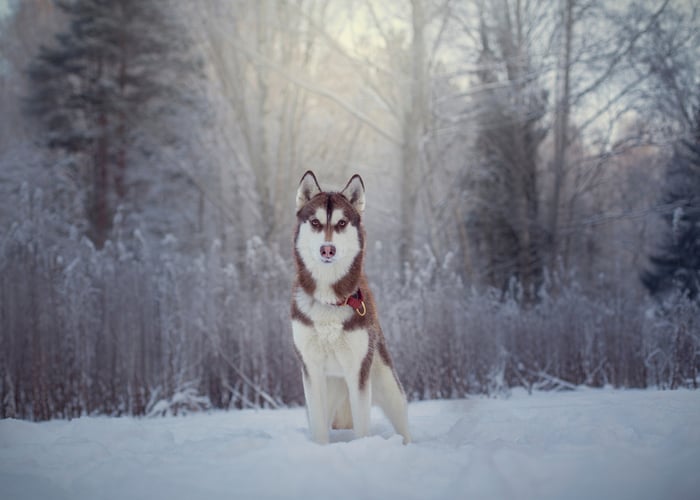
Living With Siberian Huskies
Siberian Huskies are at their euphoria when they are present in every family activity. They love to come in and out of the house of their own free will.
They are not usually fit for apartments, but they can live in an apartment-type building when properly trained and exercised.
Siberian Huskies are very active indoors and very hyper in a large fenced-in yard.
Due to their heavy coats, they prefer cool climates. If they are in a heated environment, you should be responsible for providing them shade and air-conditioning.
Huskies need to be contained at all times because they have this fearless trait, and if allowed to let loose, they might get hit by a car, fall prey to injury, and other dangers.
When owning a Siberian Husky, you will need a yard that is fully fenced with at least 6 feet tall, no escape routes over or under the fence. Also, bury the wall 1 foot deep and combine it with a chicken wire.
Most Huskies do not prefer to sleep inside a typical dog kennel; they would rather sleep on top of it. So, the ideal dog house for them is a flat roof where they can pole themselves and watch the world.
Note: Keep this dog kennel away from fences as they can use this as a launching pad to escape
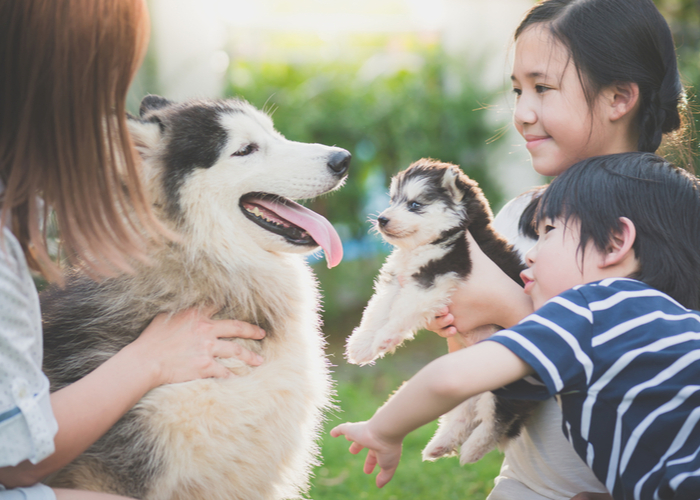
Siberian Huskies with Children and Other Pets
Siberian Huskies make good pets for households with children. They have a high tolerance with them, but adult supervision is still a must.
Huskies also get along very well with other dogs, but it's also essential to train Husky puppies in socializing. This will help them get used to other dogs and people even though they are already affectionate, even to strangers.
Keep in mind that the harsh conditions in Siberia created a strong prey drive for this Siberian Husky because of the scarcity of food.
As a result, many Huskies today still maintain this prey drive towards small animals such as squirrels, rabbits, and cats, but some Huskies can live in multi-pet households when being raised together.
History of the Siberian Husky
Siberian Huskies can be traced back to a wolf ancestor that's more than 35,000 years old. They have been believed to have originated among the Chukchi, a Siberian tribe.
The Chukchi used these dogs for fast transport and are considered family dogs. Huskies often sleep with the children and provide warm beds for them.
Siberian Huskies were imported to Alaska in 1908 and were used as sled dogs during the gold rush. They were also used in the All-Alaska Sweepstakes, a 480-mile dog sled race, and continued to be an active competitor in the Sweepstakes up to this day.
It was indicated in the records that the Last Siberian Husky was exported from Siberia in 1930 when the Soviet Government closed the borders. Huskies then continue to thrive in North America.
Even though the Siberian Huskies today changed slightly from their foundation dogs, the Chukchi Sled Dog, they still maintain many beautiful traits.
Over the years, Siberian Huskies still excelled as sled dogs. They are most recognized when they transported antitoxins to Nome, Alaska, during an epidemic of diphtheria.
The commemoration of this heroic act led to the annual Iditarod Trail Sled Dog Race. The statue of the lead dog who completed the race, Balto, was erected in Central Park, New York City, in 1925.
First Siberian Husky
Around 1925, Siberian Huskies came to Canada and other parts of the United States. During World War II, many Huskies served in the U.S Army's Search and Rescue Teams.
Siberian Huskies began to gain popularity and are now cherished as family companions.
They are the 12th most popular Arctic breed in the United States, according to AKC.
Organizations That Recognize Siberian Huskies
- American Kennel Club (AKC) in 1930
- Siberian Club of America was founded in 1938
- Canadian Kennel Club in 1939
How To Find Your Siberian Husky
Rescue Groups
Siberian Huskies are very popular dogs, so there's a big chance they'll show up at a local animal shelter – try checking them out!
You might also want to check the websites of these breed-specific rescue groups:
- Free Spirit Siberian Rescue
- MaPaw Siberian Husky Rescue
- Siberian Husky Assist Rescue
- Siberian Husky Rescue Site
Husky Breeder
The price of a Siberian Husky will depend on its lineage, location, coloring, gender, etc.
You will be expecting to pay $600 to $1,200. On average, Siberian Huskies are sold for $975.
If you purchase a Siberian Husky that is top-quality with a superior pedigree, the price will start at $1,700 up to $10,000.
You may want to visit the Siberian Husky Club of America website if you are looking for a trusted Siberian Husky breeder, as they can provide you with a directory of legit breeders.
Breeding Siberian Huskies
Unlike other breeds, it's easier to breed Siberian Huskies because of their balanced anatomy and excellent health.
The litter size of Siberian Huskies is 4 to 8 puppies, with six puppies as the reported average. The overall health of the female and male Siberian Husky matters during the breeding season.
Some factors that can affect the litter count include the size of the female Husky, her diet plan, and her inbreeding qualities.
When Siberian Huskies give birth, it usually happens without any humans around. The possibility of undergoing cesarean section for this breed is very low as their body can handle a natural birth.
Despite handling pregnancy very well, it's essential to be vigilant during their whelping to prevent any complications and puppy loss.
Also, make sure to have regular vet consultations during their pregnancy to know a possible problem.
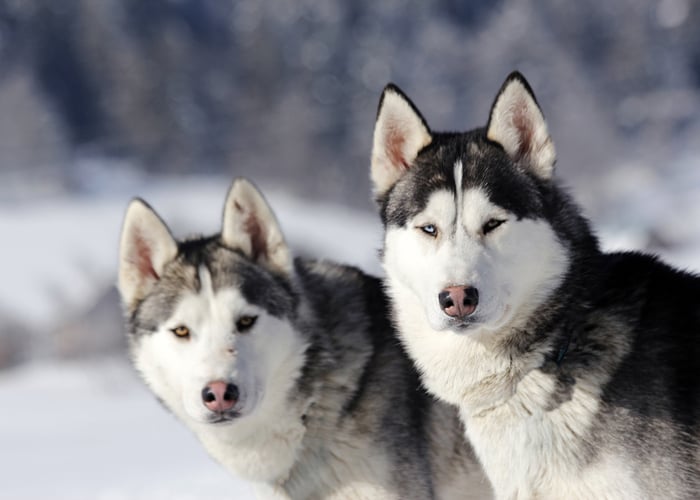
In Conclusion, is a Siberian Husky the Right Dog for You?
Siberian Huskies are intelligent and energetic dogs. They need lots of exercises, attention, and other physical stimulation.
If you're the type of person that does not have an active lifestyle and doesn't give enough attention to your pets, then a Siberian Husky may not be the right dog for you.


